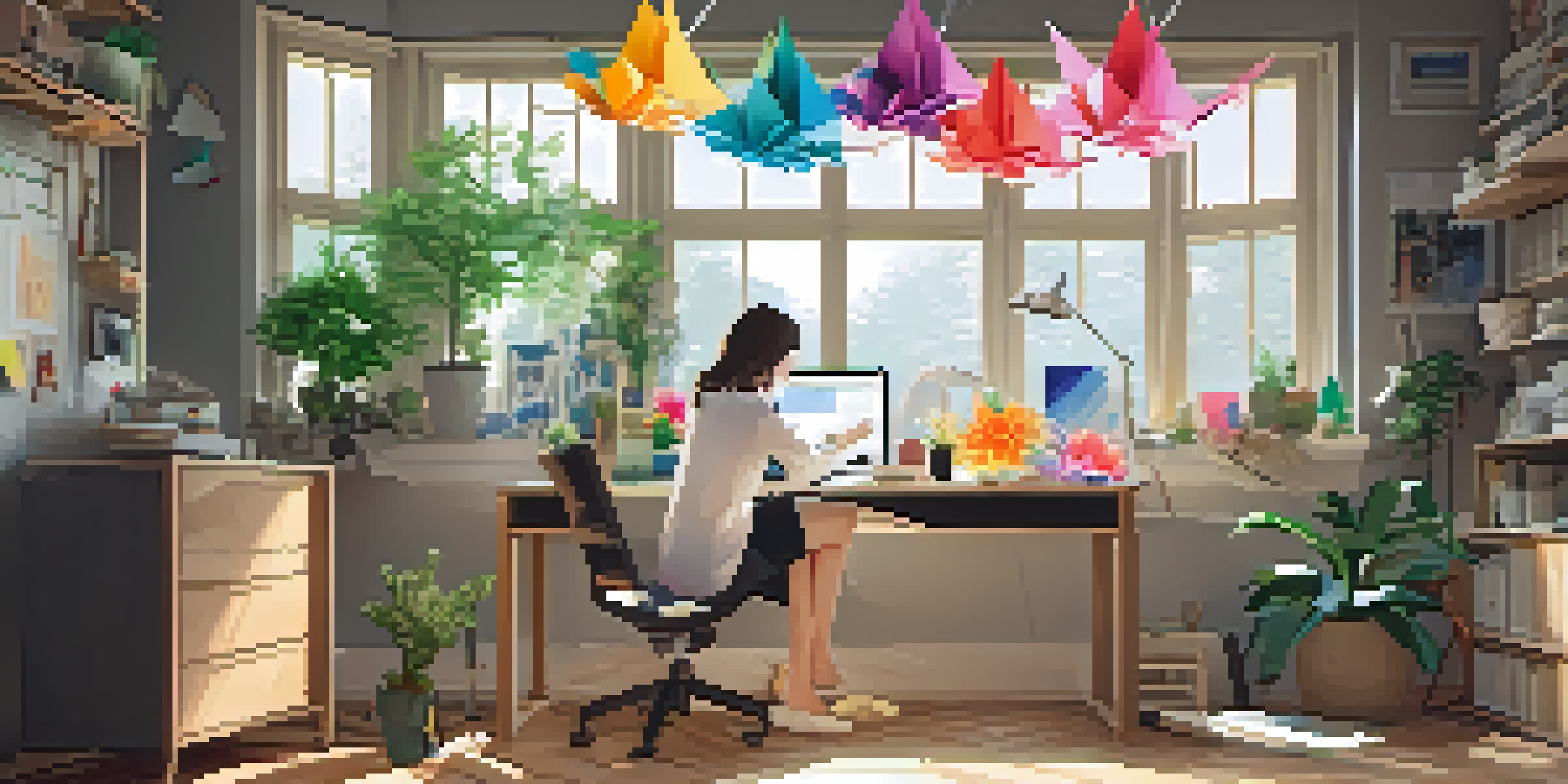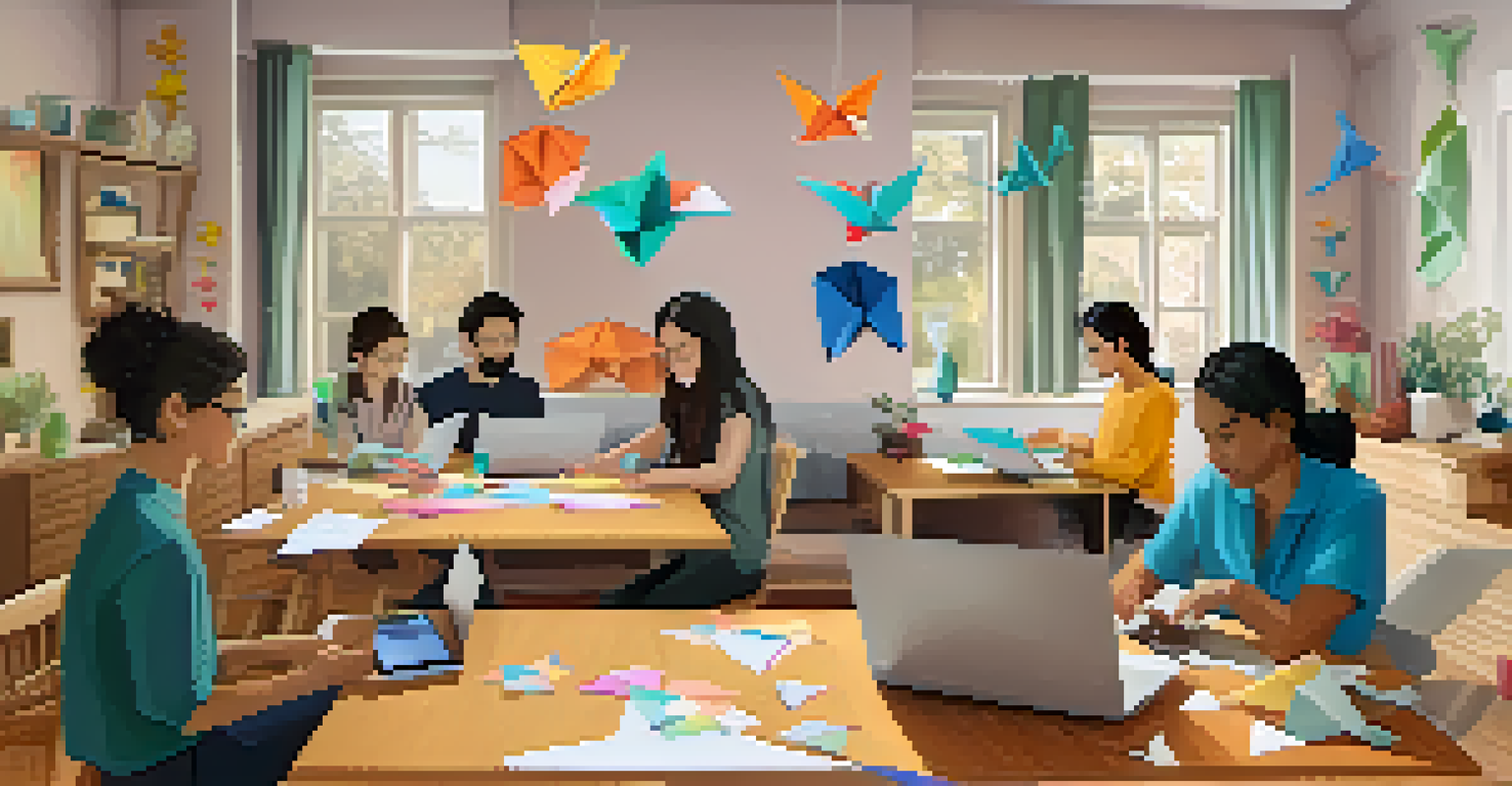Origami and Technology: Digital Tools for Modern Artists

The Fusion of Tradition and Technology in Origami
Origami, the ancient art of paper folding, has found new life in the digital age. Artists are blending traditional techniques with modern technology, creating stunning pieces that push the boundaries of this art form. With software and applications designed for origami, artists can experiment with complex designs that might have been impossible to achieve by hand.
Origami is a way of bringing together art and mathematics, and in that sense, it embodies a digital future where form and function coexist.
Digital tools enable artists to visualize their creations in three dimensions before they even touch a piece of paper. This pre-visualization not only saves time but also enhances creativity, allowing for more intricate designs. It's fascinating to see how this marriage of old and new has revitalized interest in origami among younger generations.
As a result, the art of origami is evolving, with digital platforms providing resources for both hobbyists and professionals. This shift is not just about convenience; it’s about expanding what is possible in the realm of paper art, combining craftsmanship with innovation.
Software Revolutionizing Origami Design
Several software programs have emerged that cater specifically to origami artists, offering tools for design and simulation. Programs like Origami Simulator and Pepakura Designer allow creators to draft their ideas digitally, making it easier to manipulate shapes and folds. This level of interactivity helps artists make adjustments in real time, improving the overall design process.

These programs often include libraries of existing designs, which provide inspiration and a solid foundation for new creations. Artists can dissect these works to understand the underlying principles, further enhancing their skills. By offering a platform for experimentation, these tools encourage a playful approach to origami.
Digital Tools Enhance Origami Art
Artists are utilizing software and apps to blend traditional origami techniques with modern technology, allowing for more intricate and innovative designs.
Moreover, the ability to share designs online has fostered a collaborative community. Artists can exchange tips, tricks, and completed projects, enriching the art form as a whole. It's a dynamic space where innovation thrives, and everyone can contribute.
3D Printing: Bridging the Gap Between Digital and Physical
3D printing has opened up a whole new world for origami artists, allowing them to create physical models from their digital designs. This technology enables intricate and precise creations that traditional methods might struggle to replicate. Imagine turning a complex digital origami pattern into a stunning 3D object that you can hold in your hands!
Technology is the great enabler, allowing artists to expand their creativity and explore new dimensions in their work.
The use of 3D printing in origami also allows for experimentation with materials that paper alone can't achieve. Artists can use plastics, metals, or even biodegradable materials, leading to unique textures and structures. This not only enhances aesthetic appeal but also challenges the very definition of origami.
As 3D printing continues to evolve, we can expect to see even more innovative applications in the world of origami. It's an exciting time for artists who can now merge their creativity with cutting-edge technology, pushing the limits of what origami can be.
Mobile Apps: Origami at Your Fingertips
In a world where smartphones rule, mobile apps have made origami accessible to everyone. From beginner tutorials to advanced designs, these apps can guide users through the folding process step-by-step. This convenience means that anyone, regardless of skill level, can dive into the world of origami with just a few taps on their screen.
Apps like Origami: The Art of Paper Folding and Foldify not only offer instructions but also allow users to create custom designs. They serve as a digital canvas where imagination meets technology, and users can save their creations for future reference. This blend of fun and functionality encourages more people to explore the art of origami.
3D Printing Expands Creative Possibilities
The advent of 3D printing enables origami artists to transform digital designs into physical models, pushing the boundaries of what can be achieved with traditional paper folding.
As these apps continue to improve, they are likely to include features like augmented reality, allowing users to visualize their folds in real time. This could revolutionize the learning process, making it even more interactive and engaging. The future of origami is undoubtedly in the hands of technology.
Online Communities: Connecting Origami Enthusiasts
The internet has birthed numerous online communities where origami enthusiasts can connect and share their passion. Platforms like Reddit, Facebook, and dedicated origami forums provide spaces for artists to showcase their work, share tips, and seek feedback. These communities have become invaluable resources for both novices and seasoned creators alike.
Being part of an online community fosters a sense of belonging and encourages collaboration. Members often participate in challenges or group projects, which can spark creativity and lead to unexpected results. It’s heartwarming to see individuals from all over the world come together, united by their love for this intricate art form.
Additionally, many artists host virtual workshops or live streams, making learning more accessible than ever. These interactive sessions allow participants to ask questions in real time, bridging the gap between instructor and learner. The sense of connection these communities provide is one of the most rewarding aspects of the modern origami landscape.
Social Media: Showcasing Origami Art to the World
Social media platforms have transformed how artists share their work, and origami is no exception. Instagram, TikTok, and YouTube allow artists to showcase their creations through videos and images, reaching a broader audience than ever before. This visibility can lead to new opportunities, whether it’s collaboration, commissions, or simply gaining a following.
The visual nature of these platforms makes origami particularly appealing, as viewers can appreciate the intricacies of the folds and designs in real-time. Artists often share time-lapse videos of their folding process, captivating audiences and demystifying the art form. This transparency can inspire others to pick up origami as a hobby or to experiment with their own designs.
Online Communities Foster Collaboration
Digital platforms connect origami enthusiasts globally, encouraging collaboration, sharing of techniques, and participation in challenges that inspire creativity.
Moreover, social media has facilitated global trends in origami, with challenges and hashtags bringing together artists from different cultures. This exchange of ideas not only enriches the origami community but also promotes cultural appreciation and understanding. It’s a beautiful example of how technology can connect us through art.
The Future of Origami in a Digital World
As technology continues to advance, the future of origami looks incredibly promising. Artists are constantly discovering new ways to integrate digital tools into their creative processes, leading to innovative techniques and styles. The possibilities seem endless, from augmented reality experiences to interactive installations that invite viewer participation.
Furthermore, the growing interest in sustainable materials and practices may inspire a new wave of origami that focuses on eco-friendly options. Artists might explore using recycled materials or creating designs that promote environmental awareness. This could add another layer of depth to the art form, making it both beautiful and meaningful.

Ultimately, the evolution of origami in the digital age highlights the importance of adaptability in the arts. By embracing technology, origami artists can continue to inspire, educate, and connect with others, ensuring that this timeless craft remains vibrant and relevant for generations to come.